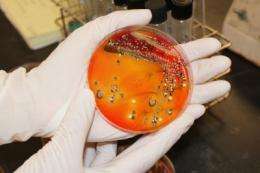Scientist develops salmonella test that makes food safer, reduce recalls

Earlier this year, an outbreak of salmonella caused by infected eggs resulted in thousands of illnesses before a costly recall could be implemented. Now, University of Missouri researchers have created a new test for salmonella in poultry and eggs that will produce faster and more accurate results than most currently available tests. The new test could have prevented the contaminated eggs from being shipped to stores.
"Processors and consumers will benefit from the speed and sensitivity of the new test's results," said Azlin Mustapha, associate professor of food science in the College of Agriculture, Food and Natural Resources. "This will keep companies from shipping contaminated products, and thus, keep salmonella infected products out of consumers' hands."
Salmonella is the most common cause of food poisoning in the United States, according to the Centers for Disease Control. Salmonellosis, the disease caused by salmonella, causes diarrhea, vomiting, fever, abdominal cramps and, in severe cases, death. Mustapha said salmonella testing in poultry is important because it persists in birds' spleens and reproductive tracts. An infected bird passes the infection on to all of its eggs.
The most commonly used testing method for salmonella can take up to five days to produce results. Mustapha's research allows scientists to use a process, known as polymerase chain reaction (PCR), which can cut testing time to as little as five to 12 hours. PCR-based testing methods for salmonella have been available for use by the food industry for years, but current methods often produce false-positive results because they do not differentiate between live and dead salmonella, thus skewing the accuracy of the test. Only live salmonella cells trigger salmonellosis.
Mustapha modified the PCR test by adding a dye to the test sample. The dye is absorbed by dead salmonella cells; thus, the PCR test can ignore the dead cells. Mustapha's modification lets food scientists use the PCR test to capitalize on its speed, selectivity and sensitivity, but avoid false-positive tests by differentiating between dead and live cells.
The reduced testing time would enable companies to have accurate test results before a product is shipped. With current tests, food could be in stores before salmonella test results are available. This new technology will enable companies to avoid costly recalls and keep consumers safe.
Mustapha said both companies and testing agencies could use the testing process she has developed. Companies must make an initial investment in a PCR instrument and train personnel to use it. However, she said the system requires less labor and time than conventional testing techniques. A similar process developed by Mustapha to detect E. coli in ground beef has been adopted by the Missouri Department of Agriculture.
More information: The research results were published recently in the Journal of Food Science.
Provided by University of Missouri-Columbia


















